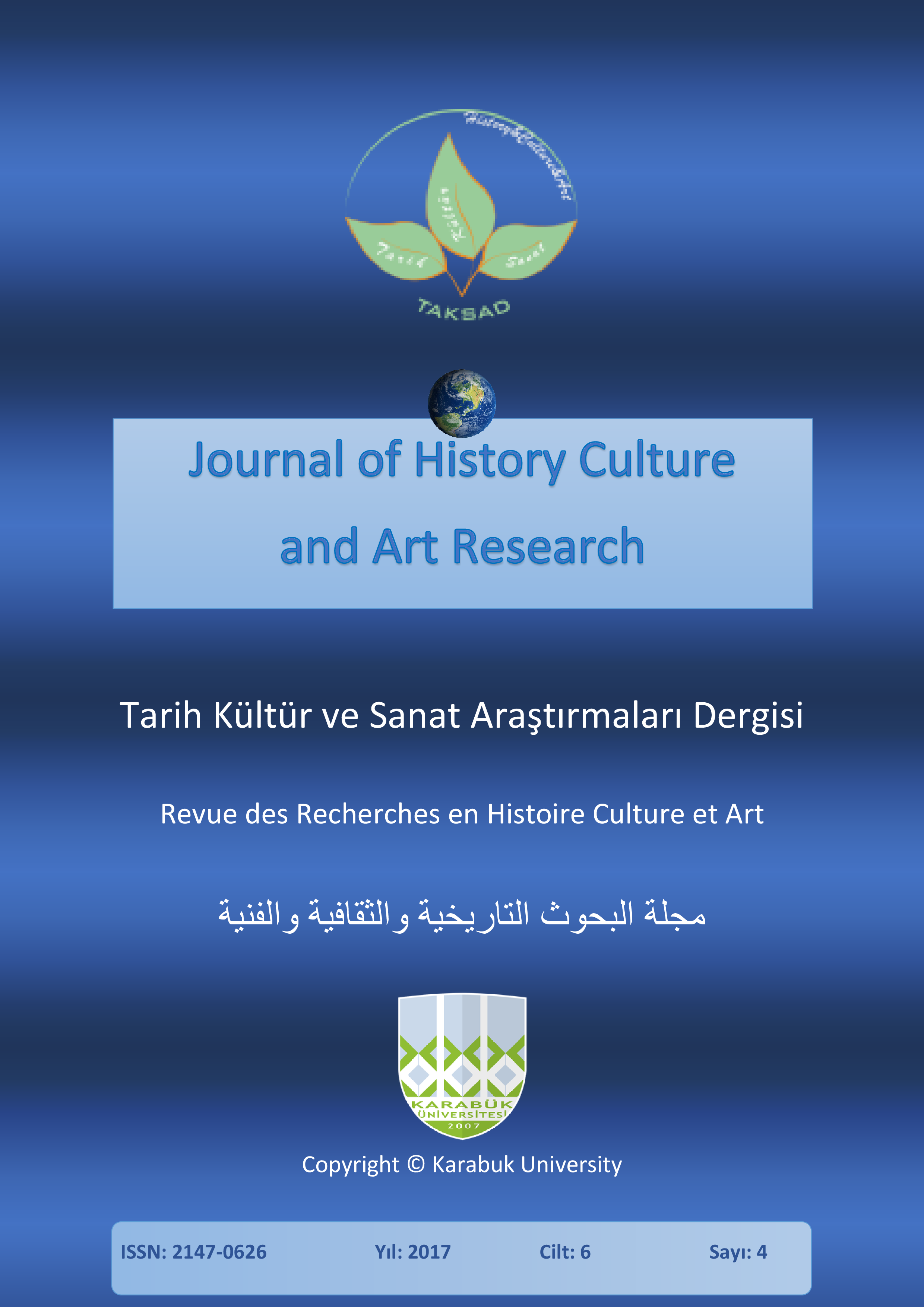Explaining the Criteria of Designing Urban Furniture and Landscape, with a Cultural-social Design Approach
DOI:
https://doi.org/10.7596/taksad.v6i4.1034Anahtar Kelimeler:
Urban furniture- Cultural-social design- Design criteria and elements.Özet
Attention to the deep relationship between human personality and the place in which he lives causes the place to play a crucial role in cultural transformations and prevalence of human life style and formation of values, connections and human activities. Cities are not just a place of transit, but they are also environments that must have mutual communications with the inhabitants in order to realize the meaning of citizen, as there is a distinction between the status of citizenship and urbanization. Urban furniture is one of the elements of urban space that its quantity, beauty and durability play a major role in achieving a healthy and favorable city and satisfies the needs of citizens in terms of performance and beauty. Accordingly, the present study, using descriptive-analytical method and with data collection tools including library and documentary studies, examines the concept of product ecology and answers to the questions whether urban furniture can start or support social interaction or positively affect the roles of citizens? In this paper, the relationship between social-cultural design in urban furniture and the disturbances regarding uneven distribution of elements are identified, and finally the criteria of designing urban furniture and landscape are expressed with a social-design approach.
Referanslar
Abdi, F. & Fatholla Nejad, S. (2014). Urban furniture element design. Conference on Quality Improvement of Urban Landscape, Tehran, Iran.
Amini, A. & Semiari, A. (2006). Design of fitting urban furniture. National Conference on Urban Environment Fitting, Research Institute for Engineering and Veterans Medical Sciences, Tehran.
Asl Fallah, M. (2010). Basics of designing urban furniture elements; Improvement instead of beautification. Proceedings of the first conference on environmental graphics and urban furniture; Isfahan, Mobarakeh Applied Scientific University.
Cheshmeh Ghesabani, M.; Barzegar, Z. & Habib, F. (2011). Prioritization of Effective Building Energy Consumption Parameters Using AHP. Naqhse Jahan Journal, (2), 47-53.
Ghasemi, M. (2011). Furniture in the urban landscape. Monthly of Educational and Research Information, Third Year, No. 23.
Gupta, N. & Bhatti, V. (2015). Importance of Street Furniture in Urban Landscape. International Journal of Latest Trends in Engineering and Technology (IJLTET), 5(3).
Hall, S. (1997). Representation: Cultural representation and signifying Practices, London: Sage/Open University.
Kidd, W. (2002). Culture and Identity. Basingstoke: Palgrave.
Lang, J. (2007). Urban design: typology of procedures and designs; translated by Seyed Hossein Bahreini. Tehran: Tehran University.
Mortezaei, R. (2014). Meaningful qualities in design. Scientific-Research Journal of Visual and Applied Arts, No. 13, Spring and Summer.
Moshabaki Esfahani, A. (2014). The Role of Localization in Upgrading Urban Identity (A Case Study of Tehran Region- Two Municipality, Seven – District). International Journal of Basic Sciences & Applied Research, (3), 232-244.
Mousavi, N. (2014). The role of urban elements in urban spaces identity. the National Conference on Architecture and Sustainable Urban Landscape, Mashhad, International Institute for Architectural and Urban Studies, Mehraz Shahr.
Naghizadeh, M; Zamani, B. & Karami, E. (2010). Cultural considerations in formation of urban landscapes based on the structure of Iranian urban landscapes in Islamic period. Urban Identity Journal, 5(7), 61-74.
Nahibi, S. & Hasan Dokht, M. (2014). Examining the effect of urban green space on improving the quality of urban life (case study: Shian district), Journal of Sustainability of Development and Environment, 1(1), (successive 2), 51-70.
Sadeghi, L.; Amerian Bani, J. & Zoogi, A. (2011). The role of urban planning in security improvement; Journal of Kurdistan Regulatory Knowledge, Second Year, No. 8.
Warren, S. (1995) Vanishing street furniture. Newton: David and Charles.
Zafarabadi, F; Rezaei, M. & Panahi, L. (2015). Examination and Measurement of the Extent of Citizens, Satisfaction with Urban Furniture (Case Study: Ghasroldash-City of Shiraz). International Journal of Review in Life Sciences, 5(1), 208-218.
Zandieh, R. & Zandieh, M. (2006). The role of urban furniture in urban identity and landscape. Conference of Supreme City, Supreme Design, Tehran, Iran.
Zeinali, S. & Beik Babaei, B. (2015). Review Article: Organizing the Urban Furniture, International Research Journal of Management Sciences, 3(1), 9-13.
İndir
Yayınlanmış
Nasıl Atıf Yapılır
Sayı
Bölüm
Lisans
Tarih Kültür ve Sanat Araştırmaları Dergisi'nde yayımlanan tüm çalışmalar Creative Commons 4.0 CC-BY lisansı ile lisanslanmıştır.
Bunları yapmakta özgürsünüz:
- Bu eseri her boyut ve formatta paylaşabilir — kopyalayabilir ve çoğaltabilirsiniz.
- Materyalden Adapte et — karıştır, aktar ve eserin üzerine inşa et
- her türlü amaç için, ticari amaç da dahil
Alttaki şartlar altında:
Atıf — uygun bilgiyi, lisansa linki, and ve değişiklik yapıldıysa değişiklik bilgisinivermelisiniz. Sizi veya kullanımınızı lisansörün onayladığı bilgisini içermemek kaydıyla, size uygun şekilde bu işlemleri gerçekleştirebilirsiniz.
AynıLisanslaPaylaş — Eğer materyali karıştırdınızsa, aktardınızsa ya da materyalin üzerine çalıştınızsa, ancak aynı lisans ile dağıtabilirsiniz.
- Ek sınırlamalar yoktur — Lisansın izin verdiği hakları başkaları üzerinde kanunlarla ya da teknolojiyikullanarak sınırlayamazsınız.







